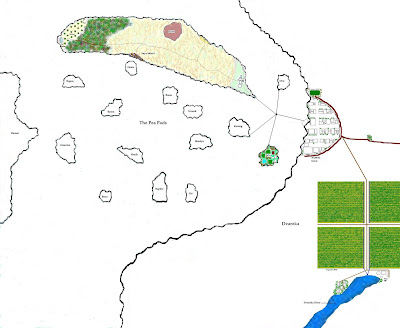 Map of Saya Island and nearby islands, part of Pya cluster; © 2009 Maggie Jochild.
Map of Saya Island and nearby islands, part of Pya cluster; © 2009 Maggie Jochild.
Mostly, I've been dealing with some major health issues involving my GI tract and severe pain. I've have four bed-confining episodes in the past two weeks. Sitting up to write has been extremely limited, and I'm saving that time for my paying job, such as it is.
I've also been working on another enormous blog project, which I'll tell you about soonish. Working as in figuring out details and making notes on paper.
However, when lying in bed wracked with pain, considering politics/real world issues is not a helpful distraction. Nor are my usual narcotic, cooking shows. During the first knock-out, I also discovered I couldn't write Ginny Bates episodes in my head. I need to stop writing there and begin editing, and since I don't have a hook yet to launch that endeavor, my mind is now refusing to create new Ginny stories.
In desperation, I tried to think of another story, something that would take my artistic drive and run with it. What came to me was hopscotching ahead from my previous (Myra-related) novel Skene and beginning the next book in that series -- working title right now is Pya . I have only written a few paragraphs of actual exposition, but in my head I've outlined the book and even begun drawing maps on paper. It's been unlimited comfort.
Skene is a science fiction novel set over 500 years in the future. Plot synopsis is that Earth sends out a group of approximately 100 specialists (all races, genders, nationalities, ages) to an ocean planet in the constellation Alhena with plans to mine the sea and a single cluster of islands found amid all that water. As in most sci fi novels, this is a story of "when it changed" -- but it's not about the original colonization effort. Instead, I begin the narrative 500 years after first landfall. In the interim, three main developments have occurred:
(1) The original plan was for the colonists to make a 4-year commitment, one year each way in travel and two years setting up the planet for mining. At the end of their hitch, a new set of colonists will arrive to take their place. However, for reasons never known or explained, Earth never sends replacements. The original group is left forever on their own.
(2) Something about the water world begins altering human biology, specifically gender and procreative biology. Male fertility takes a hit and continues declining, and increasingly fewer numbers of male children are born. By the time my novel begins, only one in six births is male and of those, only 10% will be fertile enough to create a pregnancy. As a consequence of several factors (including mass insanity when the change is first realized), Skene culture now prohibits any identity based on gender. Your immediate family and lover/partners will know if you are X or Y, as they refer to it, but no one else. All sexual, occupational, community, familial, and even procreative behavior is based on individual traits, not gender categories. Further, with the collapse of the gender binary, along with other causative factors, class and race differentiation has also disappeared. Skene has created a progressive meritocracy combined with other forms of non-traditional repression.
(3) As if they didn't have enough problems, the original colonists discover that one of the indigenous life forms, all of which were presumed to be benign and barely sentient, is not simply a whale-sized fish but in fact a clever carnivorous predator. Humanity on Skene is confined to existence on its 39 small islands, 24 of which are truly tiny land masses. They have futuristic technology but extremely limited natural resources.
N.B. The name Skene is a lesbian inside joke.
Skene covers a period of about 15 years, following the lives of three women who bring profound change to Skene. There's a lot of great sex, political machinations, environmental dilemmas, alternative family life, and extreme adventure. I ended the book with an Epilogue about 20 years in the future, just as Skene is about to make another quantum leap of cultural reformation.
I begin Pya 25 years after Skene's epilogue, focusing on the grandchild of the three main characters in Skene (who was not born by the aforementioned Epilogue). She and her cohort are, again, caught at the moment after one set of "when it changed" has occurred, but another is poised to make demands of them. With Pya, I build on the social structure, language, lineage, geography, and memes established in Skene. However, it has required a whole new set of maps, family additions, and language amplification, all of which is delicious fun to create for me, the anthropology student.
If you want to read Skene, look in the labels in the right-hand column and begin with Chapter One. All the chapters in Skene are in numerical order. There is also a wealth of appendix material: A dictionary, an explanation of the culture, cast of characters, maps of the island, and more, all itemized under Skene in my labels and also accessible through Chapter One.
Once I get the actual writing under way, I may post chapters of Pya here, if there's interest. My web statistics have shown me there's a fair number of Skene readers out there, so let me know if you want access to the new raw material.
More update on other issues later. For now, I have to do some Work.
Monday, July 13, 2009
BRIEF UPDATE: PAIN AND PYA
Posted by
Maggie Jochild
at
5:49 AM
![]()
Labels: daily journal, disability, Pya, Skene
Subscribe to:
Post Comments (Atom)





2 comments:
I would LOVE to read Pya. I have been enjoying Skene very much.
I hate that you're in such pain, Mags. Love to you, dear one.
Thanks for keeping us apprised of the situation, Maggie. Sending good thoughts your way!
Post a Comment